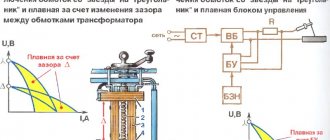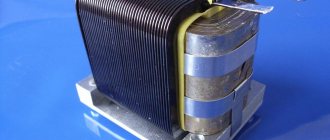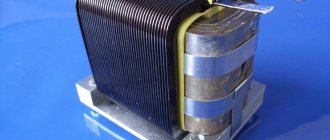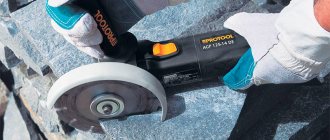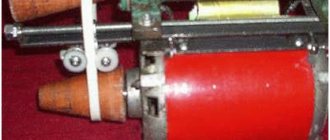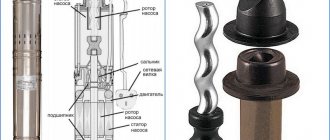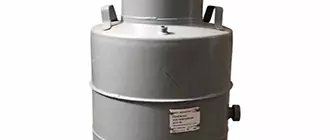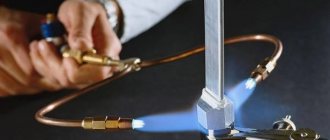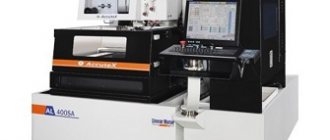What is a semiconductor diode - AC rectifier
Diodes are two-electrode devices that have one-way conductivity of electric current.
This main property is used, for example, in rectifiers, where diodes convert alternating current from the mains into direct current to power radio equipment, in receivers - to detect modulated high-frequency oscillations, that is, convert them into low (sound) frequency oscillations. A clear illustration of this property of a diode can be seen in the following experiment. In a circuit made up of a 3336L battery and a light bulb from a flashlight (3.5 V X 0.26 A), connect any planar diode, for example, from the D226 or D7 series, but so that the anode of the diode, designated conventionally by a triangle, would be connected directly or through a light bulb to the positive pole of the battery, and the cathode, indicated by the dash to which the corner of the triangle adjoins, to the negative pole of the battery. The light should be on.
Diode sizes.
Change the polarity of the battery to reverse - the light will not light. If the resistance of a diode is measured with an ohmmeter, depending on how you connect it to the terminals of the device, the ohmmeter will show different resistance: in one case it is small (units or tens of ohms), in the other it is very large (tens and hundreds of kilo-ohms). This confirms the one-way conductivity of the diode.
The diode has two electrodes: the cathode is negative and the anode is positive (Fig. 13). The cathode is a plate of germanium, silicon or some other semiconductor with electronic conductivity, or abbreviated n-type semiconductor (n is the initial letter of the Latin word negativus - “negative”), and the anode is part of the volume of the same plate, but so called hole conductivity, or abbreviated p-type semiconductor (p is the initial letter of the Latin word positivus - “positive”).
A so-called p-n junction is formed between the electrodes - a boundary zone that conducts current well from the anode to the cathode and poorly in the opposite direction (the direction of the current is taken to be the direction opposite to the movement of electrons). The diode can be in one of two states: open, that is, passing, or closed, that is, non-passing. The diode is open when a direct voltage Upr is applied to it, otherwise, its anode is connected to the plus of the voltage source, and the cathode is connected to the minus.
In this case, the resistance of the pn junction of the diode is small and a direct current IPre flows through it, the strength of which depends on the load resistance (in our experience, a flashlight bulb). With a different polarity of the supply voltage, reverse voltage Urev is applied to the pn junction of the diode. In this case, the diode is closed, its resistance is high and only a small reverse diode current Irev flows in the circuit. The dependence of the current passing through the diode on the value and polarity of the voltage at its electrodes is best judged by the current-voltage characteristic of the diode, which can be measured experimentally.
Different types of diodes.
Characteristics
Each type of semiconductor has its own operating and limiting parameters, which are selected in order to ensure operation in any circuit.
Parameters of rectifier diodes:
- I direct max
- direct current, which is the maximum permissible, A. - U reverse max
- reverse voltage, which is the maximum permissible, V. - I reverse
- constant reverse current, µA. - U direct
- direct voltage constant, V. - Operating frequency
, kHz. - Operating temperature
, C. - P max
is the maximum permissible power dissipated by the diode.
The characteristics of rectifier diodes are far from exhausted by this list. However, they are usually sufficient to select a part.
Diodes and their varieties
We very often use diodes in our circuits, but do you know how they work and what they are? Today, the “family” of diodes includes more than a dozen semiconductor devices called “diodes”. A diode is a small container with evacuated air, inside which, at a short distance from each other, there is an anode and a second electrode - a cathode, one of which has electrical conductivity of type p, and the other - n.
To imagine how a diode works, let’s take as an example the situation of inflating a wheel using a pump. Here we are working with a pump, air is pumped into the chamber through the nipple, but this air cannot escape back through the nipple. Essentially, air is the same electron in a diode; an electron has entered, but it is no longer possible to get back out. If the nipple suddenly fails, the wheel will deflate and there will be a breakdown of the diode. And if we imagine that our nipple is working properly, and if we press the nipple pin to release air from the chamber, and press as we want and for how long, this will be a controlled breakdown. From this we can conclude that the diode passes current only in one direction (it also passes in the opposite direction, but very little).
The internal resistance of a diode (open) is not a constant value; it depends on the forward voltage applied to the diode. The higher this voltage, the greater the forward current through the diode, the lower its throughput resistance. You can judge the resistance of a diode by the voltage drop across it and the current through it. So, for example, if a direct current Ipr flows through the diode. = 100 mA (0.1 A) and at the same time the voltage across it drops 1V, then (according to Ohm’s law) the forward resistance of the diode will be: R = 1 / 0.1 = 10 Ohms.
I’ll note right away that we won’t go into details and go deep, draw graphs, write formulas - we’ll look at everything superficially. In this article we will consider the types of diodes, namely LEDs, zener diodes, varicaps, Schottky diodes, etc. The triangular part is the ANODE, and the dash is the CATHODE. The anode is a plus, the cathode is a minus. For example, diodes are used in power supplies to rectify alternating current; with the help of a diode bridge, alternating current can be converted into direct current; they are used to protect various devices from incorrect polarity, etc.
What types of diodes exist.
There are several main types of diodes:
- Schottky diode. Schottky diodes have a very low voltage drop and are faster than conventional diodes. It is not recommended to install a regular diode instead of a Schottky diode; a regular diode can quickly fail. Such a diode is designated in the diagrams as follows:
- Zener diode. The zener diode prevents the voltage from exceeding a certain threshold in a specific section of the circuit. It can perform both protective and restrictive functions; they only work in DC circuits. When connecting, the polarity must be observed. Zener diodes of the same type can be connected in series to increase the stabilized voltage or form a voltage divider. The main parameter of zener diodes is the stabilization voltage; zener diodes have different stabilization voltages, for example 3V, 5V, 8.2V, 12V, 18V, etc.
- Varicap. A varicap (or capacitive diode) changes its resistance depending on the voltage applied to it. It is used as a controlled variable capacitor, for example, for tuning high-frequency oscillatory circuits.
- Thyristor. The thyristor has two stable states: 1) closed, that is, a state of low conductivity, 2) open, that is, a state of high conductivity. In other words, it is capable of transitioning from a closed state to an open state under the influence of a signal. The thyristor has three terminals, in addition to the Anode and Cathode, there is also a control electrode - used to switch the thyristor to the on state. Modern imported thyristors are also produced in TO-220 and TO-92 cases. Thyristors are often used in circuits to regulate power, to smoothly start motors or turn on light bulbs. Thyristors allow you to control large currents. For some types of thyristors, the maximum forward current reaches 5000 A or more, and the voltage value in the closed state is up to 5 kV. Powerful power thyristors of the type T143 (500-16) are used in control cabinets for electric motors and frequency converters.
- Triac. A triac is used in systems powered by alternating voltage; it can be thought of as two thyristors that are connected back-to-back. The triac allows current to flow in both directions. Light-emitting diode. An LED emits light when electric current is passed through it. LEDs are used in instrument display devices, electronic components (optocouplers), cell phones for display and keyboard backlighting, high-power LEDs are used as a light source in flashlights, etc. LEDs come in different colors, RGB, etc.
- Infrared diode. Infrared LEDs (abbreviated IR diodes) emit light in the infrared range. The areas of application of infrared LEDs are optical instrumentation, remote control devices, optocoupler switching devices, and wireless communication lines. IR diodes are designated in the same way as LEDs. Infrared diodes emit light outside the visible range, the glow of an IR diode can be seen and viewed, for example, through a cell phone camera, these diodes are also used in CCTV cameras, especially on street cameras so that the picture can be seen at night.
- Photodiode. A photodiode converts light falling on its photosensitive region into electric current, and is used in converting light into an electrical signal.
We recommend reading: About connecting a voltmeter: diagram of connecting voltmeters to a circuit
Diode bridge
A diode bridge is a compact circuit that is made up of four diodes and serves the purpose of converting AC to DC. The bridge circuit makes it possible to pass current in each half-cycle, which distinguishes it favorably from the half-wave circuit. Diode bridges are produced in the form of small-sized assemblies, which are enclosed in a plastic housing.
At the output of the housing of such an assembly there are four pins marked “+”, “—
" or "
~
" to indicate the purpose of the contacts. However, diode bridges are also found not in an assembly; they are often assembled directly on a printed circuit board by connecting four diodes. The rectifier, which is performed on a diode bridge, is called full-wave.
Types of diodes
LED elements are divided into 2 volumetric types: semiconductor and non-semiconductor. The device of the first involves a small container with pumped out air and two electrodes inside:
- Plus, having electrical conductivity P.
- Minus, which has electrical conductivity N.
Non-semiconductor diodes are in turn divided into 2 more groups:
- Vacuum (kenotrons), built on the principle of a lamp having 2 electrodes, where one of them is represented as an incandescent filament. In the slightly open position, the movement of electrons is from the pole to the minus. In the closed position, the movement path changes in the opposite direction or is suspended.
- Filled with gas (zener diodes with a smoldering or corona charge of ignitrons and gastrons). Of the voluminous list of elements, the most popular are gastrons with an arc charge (zener diodes). An inert gas is pumped inside them and oxide thermal cathodes are placed. The key feature of such LEDs is the ability to produce high output voltage and the ability to operate with voltage, the value of which can reach several tens of amperes.
Important! The value of resistance in the closed position is directly related to the value of forward current. If it is high, then the resistance will be low.
Types of diodes
The main division of diodes occurs according to their type. There are three categories: material of manufacture, pn junction area and purpose.
To produce diodes, one of four initial semiconductors is used:
- germanium - in low-power and precision circuits, has a higher transmission coefficient;
- silicon – inexpensive and durable, resistant to temperature, but less conductive;
- gallium arsenide – more expensive and more complex than silicon, high radiation resistance;
- indium phosphide - in LEDs and for operation at ultrahigh frequencies.
Each material in different systems has its own letter or number, which is indicated at the beginning.
There are two options for the structural placement of the cathode and anode:
- Point diode. One of the electrodes in the form of a narrow needle is fused into the crystal, forming a pn boundary. It has a small area, which results in a high operating frequency. They are almost out of use due to low strength, vulnerability to overloads and low maximum current.
- Planar diode. The transition area is larger - the contact passes over the area of the semiconductor wafer connected to the crystal. They are distinguished by higher capacity, low noise level, and low voltage drop. An example is a Schottky diode.
In modern marking, separation practically does not occur - planar diodes are gradually replacing point diodes.
The following designation depends on the purpose of the device. There is a classification of diodes used in different areas: tunnel, laser, varicaps, zener diodes. There is also a division within the subtype, based on technical parameters:
- operating frequency;
- recovery time;
- forward and reverse current;
- permissible values of reverse and forward voltage;
- temperature regime.
We recommend reading: Stabilizer AMS1117-3
This results in a large number of possible combinations, hence the difficulty of creating a unified labeling system.
Color coding
For diodes, a standard type of box is used under the designation SOD123 . There is an embossed or colored gauge strip on one end. Kohler is talking about a code where there is a negative polarity to broaden the pn junction.
The color coding of diodes takes into account:
- indicators of reverse and operating voltage;
- value of the limiting current through the pn junction;
- transmission power and other indicators.
The type of box is not decisive in the operation of the diode. In this case, an important characteristic is the degree of heat dissipation from the plane of the element.
Domestic diodes
Russian manufacturers use color-coded inscriptions that include dots and stripes. You can decipher the combination by referring to specialized reference books. In this case, they find the material of production, the purpose of the diode, and performance indicators.
Modern manufacturers of diodes in the diagram designate products taking into account the requirements of GOST 20.859.1 - 1989. There is a standardized table for domestic color marking.
It contains a designation of the material, and according to the standards, the letter K (silicon) can be replaced with the number 1. The second letter indicates that the product is a rectifier (D) based on a varicap (B), a zener diode (C), and a tunnel diode (I).
Imported diodes
Diodes manufactured abroad also have a color scale as a marking. For reading, digital and alphabetic symbols are used, which are deciphered using a special table.
When releasing, use the diode symbol:
- JEDEC - American base;
- PRO-ELECTRON 1 European manufacturers.
In Europe, the first letter indicates the type of production raw material, followed by information about the purpose and type of the element.
The series number indicates the method of application:
- for general use;
- in special systems.
Decoding the symbols of the European system:
SMD diodes
Elements are more often foreign-made. Their structure is made in the form of a board, on the surface plane of which there is a fixed chip. The products are so small that they do not allow markings with numbers and letters (applying the designation to the surface). If the models are larger, all parameters are indicated in letters, numbers and color.
SMD models are represented by electronic parts of microscopic dimensions. During assembly, they are soldered to the copper side of the board, while the diodes are equipped with only short lead contacts. Comparative characteristics of the alphabetic and digital designations are found in the tables.
Device
Below is a detailed description of the diode structure; studying this information is necessary for further understanding of the principles of operation of these elements:
- The housing is a vacuum cylinder that can be made of glass, metal or durable ceramic varieties of material.
- There are 2 electrodes inside the cylinder. The first is a heated cathode, which is designed to ensure the process of electron emission. The simplest cathode in design is a filament with a small diameter, which heats up during operation, but today indirectly heated electrodes are more common. They are cylinders made of metal and have a special active layer capable of emitting electrons.
- Inside the cathode-indirect glow there is a specific element - a wire that glows under the influence of electric current, it is called a heater.
- The second electrode is the anode, it is needed to receive the electrons that were released by the cathode. To do this, it must have a potential that is positive relative to the second electrode. In most cases, the anode is also cylindrical.
- Both electrodes of vacuum devices are completely identical to the emitter and base of the semiconductor variety of elements.
- Silicon or germanium is most often used to make a diode crystal. One of its parts is p-type electrically conductive and has a deficiency of electrons, which is formed by an artificial method. The opposite side of the crystal also has conductivity, but it is n-type and has an excess of electrons. There is a boundary between the two regions, which is called a pn junction.
Such features of the internal structure give diodes their main property - the ability to conduct electric current in only one direction.
Manufacturing technology
The design of a rectifying diode is a wafer of a semiconductor crystal, in the body of which there are two regions with different conductivities. This is the reason why they are called planar.
Semiconductor rectifier diodes are made like this: in the region of the semiconductor crystal with n-type conductivity, aluminum, indium or boron is melted, and in the region of the crystal with p-type conductivity, phosphorus is melted.
When exposed to high temperatures, these two substances are firmly fused to the semiconductor base. In addition, the atoms of these materials diffuse into the crystal to form a region with predominantly electronic or hole conductivity. As a result, a semiconductor device is formed that has two regions with different types of electrical conductivity, and a pn junction is formed between them. This is the operating principle of the vast majority of planar diodes made of silicon and germanium.
Direct diode connection
The pn junction of the diode can be affected by voltage supplied from external sources. Indicators such as magnitude and polarity will affect its behavior and the electrical current conducted through it.
Below we consider in detail the option in which the positive pole is connected to the p-type region, and the negative pole to the n-type region. In this case, direct switching will occur:
- Under the influence of voltage from an external source, an electric field will be formed in the pn junction, and its direction will be opposite to the internal diffusion field.
- The field voltage will decrease significantly, which will cause a sharp narrowing of the blocking layer.
- Under the influence of these processes, a significant number of electrons will be able to freely move from the p-region to the n-region, as well as in the opposite direction.
- The drift current indicators during this process remain the same, since they directly depend only on the number of minority charged carriers located in the pn junction region.
- Electrons have an increased level of diffusion, which leads to the injection of minority carriers. In other words, in the n-region there will be an increase in the number of holes, and in the p-region an increased concentration of electrons will be recorded.
- The lack of equilibrium and an increased number of minority carriers causes them to go deep into the semiconductor and mix with its structure, which ultimately leads to the destruction of its electrical neutrality properties.
- In this case, the semiconductor is able to restore its neutral state, this occurs due to the receipt of charges from a connected external source, which contributes to the appearance of direct current in the external electrical circuit.
Forward and reverse voltage
During operation (in the open state), the main voltage in the diode depends on its value and the resistance and magnitude of the electric current. During the closing process, a current passes through the semiconductor in the opposite direction, creating a voltage that contributes to an increase in resistance to several thousand kOhms.
If a semiconductor operates on alternating voltage, it opens on the positive half-wave and closes on the negative half-wave. This property allows semiconductors to be used in rectifiers.
Diode reverse connection
Now we will consider another method of switching on, during which the polarity of the external source from which the voltage is transmitted changes:
- The main difference from direct connection is that the created electric field will have a direction that completely coincides with the direction of the internal diffusion field. Accordingly, the barrier layer will no longer narrow, but, on the contrary, expand.
- The field located in the pn junction will have an accelerating effect on a number of minority charge carriers, for this reason, the drift current indicators will remain unchanged. It will determine the parameters of the resulting current that passes through the pn junction.
- As the reverse voltage increases, the electric current flowing through the junction will tend to reach its maximum. It has a special name - saturation current.
- In accordance with the exponential law, with a gradual increase in temperature, the saturation current indicators will also increase.
How does a diode work?
You may not physically see the diodes themselves, but the result of their action surrounds us everywhere. These devices allow you to control the flow of current in a specified direction. There are many different versions of diodes. In what cases is this necessary? Below we will discuss examples and, to some extent, the operating principle of semiconductor diodes. If you add two metal plates to the P and N working areas of the material, you get anode and cathode electrodes. The scheme for connecting the electrodes to the source can work as follows: applying voltage from the battery to the N electrode ensures the attraction of positrons, respectively, to the P electrode – electrons; the absence of tension returns everything to its original state; changing the polarity of the applied voltage ensures the attraction of electrons in the opposite direction to the positive plate, and positrons to the negative one. In the latter case, excess charges accumulate on the metal plates, while a dead insulating zone is formed in the center of the material itself.
Thus, the central section of the material becomes a dielectric. The device does not pass current in this direction. The word comes from di (double) + -ode. The definition of the terms cathode and anode of a diode related to contacts is known to every person. The cathode is the negative electrode, the anode is the positive electrode. If you apply plus to the anode and minus to the cathode, the diode will open and electric current will flow through it. Thus, a diode is a device that has two electrodes: a cathode and an anode. A simple nonlinear electronic device consisting of two different semiconductors. How the diode works is clearly visible in the image.
We recommend reading: The simplest 220 volts without a driver (the simplest way to power an LED from a 220V network)
Types of diodes.
Low-frequency diodes (tablet version)
Diodes D133-400, D133-500, D133-800, D143-630, D143-800, D143-1000, D253-1600 are intended for use in DC and AC circuits with a frequency of up to 500 Hz in general-purpose electrical devices. The diodes are resistant to sinusoidal vibration in the frequency range 1-100 Hz with an acceleration of 49 m/s2 and single shocks lasting 50 ms with an acceleration of 39.2 m/s2. The anode and cathode are flat bases, with polarity identified by the polarity symbol printed on the diode body.
Low-frequency avalanche diodes are designed for use in general-purpose devices with frequencies up to 500 Hz. The diodes allow exposure to vibration loads in the frequency range of 1-100 Hz with an acceleration of 49 m/s2, multiple impacts lasting 2-15 ms with an acceleration of 147 m/s2 and single impacts lasting 50 ms with an acceleration of 39.2 m/s2. Diodes DL 161-200, DL 171-320 have a pin design. The anode of the diodes is a copper base, the cathode is a flexible lead. Diodes DL 123-320, DL133-500 have a tablet design. The anode and cathode are flat bases, with polarity identified by the polarity symbol printed on the diode body.
Possible faults
During operation of devices with diodes, various breakdowns can occur. This occurs due to aging of the elements or their depreciation.
Repair specialists distinguish 4 types of faults.
Among them are:
- Electrical breakdown. This is one of the most common failures that occur with diodes. It is reversible, since it does not lead to destruction of the diode crystal. This can be corrected by gradually reducing the supplied voltage.
- Thermal breakdown. Such a malfunction is more destructive for the diode. It occurs due to poor heat dissipation or overheating in the pn junction region. The latter is formed only if the device is powered by a current with excessively high rates. Without repairs, the problem will only get worse. In this case, the vibrations of the atoms of the diode crystal will increase, which will lead to its deformation and destruction.
- Break. When this malfunction occurs, the device stops flowing electrical current in both directions. Thus, it becomes an isolator blocking the entire system. To eliminate a breakdown, you need to accurately determine its location. To do this, special highly sensitive testers should be used, which will increase the chance of detecting a break.
- A leak. This breakdown is understood as a violation of the integrity of the housing caused by physical or other impact on the device.
The diode is an important design element that ensures proper and uninterrupted operation of the device. By choosing this element correctly and ensuring optimal operating conditions, you can avoid any malfunctions.
Main conclusions
Semiconductor diodes are radioelements with one pn junction, which are found in almost all household appliances. In order for semiconductors to work longer, you need to know the principle of operation of diodes, the causes of malfunctions and how to prevent them.
Most often, semiconductor performance is affected by changes in ambient or junction temperatures. If the temperature is too high, the amount of energy in the junction increases, the resistance decreases, and the amount of counter current increases. After reaching the maximum permissible level, the process of destruction of the crystal begins.
To avoid shortening operating time, it is necessary to monitor the temperature of the liquid and the cleanliness of the devices. If necessary, an additional heat removal system should be provided. Junction temperature increases are prevented by complying with device-specific voltage and current requirements. Even with the slightest excess, there is a possibility of crystal destruction.
Application area
The scope of use of these parts in modern radio engineering is high. It is difficult to find a device that works without these parts. To understand why a diode is needed, here are a few examples:
- Diode bridges - contain from 4 to 12 semiconductor devices that are connected to each other. The main task of diode bridges is to rectify current, and they are actively used, for example, in creating generators for cars.
- Detectors - created by combining diodes and capacitors. As a result, it becomes possible to isolate low-frequency modulation from various signals. Used in the manufacture of radio and television receivers.
- Protective devices - allow you to protect the electrical circuit from possible overloads. Several products are connected in the opposite direction. When the circuit is working normally, they remain in the closed position. As soon as the input voltage reaches critical levels, the device is activated.
- Switches - such systems based on these products allow switching high-frequency signals.
- Spark protection systems - the creation of a shunt-diode barrier allows you to limit the voltage in the electrical circuit. To increase the degree of protection, special current-limiting resistors are used together with semiconductor parts.
These are just a few examples of the use of diodes. They are quite reliable devices that can be used to solve a large number of problems. Most often, these radio components fail due to natural aging or overheating.
If an electrical breakdown of a product occurs, its consequences are rarely irreversible, since the crystal is not destroyed.
Thyristors
These parts are widely used in devices for rectifying and converting electric current, welding machines, devices for starting and controlling the speed of electric vehicles, various radio-electronic and switching installations. They are also used in structures designed to compensate for reactive power loads.
Important! Low-frequency thyristors are designed for operation at a frequency of no more than 100 hertz. Devices characterized by increased performance are designed for use in installations that require a rapid increase in open electric current and closed voltage
Thyristor part
